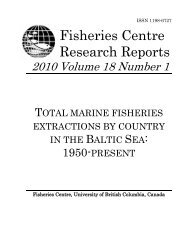Trends in GlobAl MArine Fisheries - Sea Around Us Project
Trends in GlobAl MArine Fisheries - Sea Around Us Project
Trends in GlobAl MArine Fisheries - Sea Around Us Project
You also want an ePaper? Increase the reach of your titles
YUMPU automatically turns print PDFs into web optimized ePapers that Google loves.
The North <strong>Sea</strong> LME is relatively shallow, and<br />
is situated on the cont<strong>in</strong>ental shelf of north-western<br />
Europe. The LME <strong>in</strong>cludes one of the most<br />
diverse coastal regions <strong>in</strong> the world, with a great<br />
variety of habitats (fjords, estuaries, deltas, banks,<br />
beaches, sandbanks and mudflats, marshes, rocks<br />
and islands). Among its many river systems and<br />
estuaries are the Thames, Rh<strong>in</strong>e, Elbe and Ems.<br />
A temperate climate and four seasons characterize<br />
this LME, with climate be<strong>in</strong>g an important<br />
driv<strong>in</strong>g force (after fish<strong>in</strong>g) of biomass change<br />
<strong>in</strong> the LME. Great Brita<strong>in</strong>, Norway, Sweden,<br />
Denmark, Germany, the Netherlands, Belgium<br />
and France are the countries border<strong>in</strong>g the North<br />
<strong>Sea</strong> (Sherman and Hempel 2008). Fish<strong>in</strong>g is a<br />
long-established activity <strong>in</strong> the North <strong>Sea</strong> LME<br />
and there is a wealth of fisheries data (Froese and<br />
Pauly 2003). The most important species for human<br />
consumption represented <strong>in</strong> the catch are<br />
Atlantic cod, saithe (Pollachius virens), Atlantic<br />
herr<strong>in</strong>g (Clupea harengus), European sprat<br />
(Sprattus sprattus) and flatfishes. Land<strong>in</strong>gs from<br />
the <strong>in</strong>dustrial fishmeal reduction fishery consist<br />
ma<strong>in</strong>ly of sandlances (sandeels Ammodytes spp.)<br />
Norway pout (Trisopterus esmarkii) and sprat.<br />
There are several commercially important shellfish<br />
species of molluscs and crustaceans. The<br />
BA-DAP for the North <strong>Sea</strong> LME <strong>in</strong>dicates a<br />
steady decl<strong>in</strong>e <strong>in</strong> <strong>in</strong>dicator <strong>in</strong> the early years, followed<br />
by a sudden, steep decl<strong>in</strong>e <strong>in</strong> 1970 towards<br />
strongly abundance dom<strong>in</strong>ated fisheries (Figure<br />
4). The <strong>in</strong>dex has rema<strong>in</strong>ed steady ever s<strong>in</strong>ce. It<br />
is worth not<strong>in</strong>g that throughout the time period<br />
considered here (1950–2004), the <strong>in</strong>dex was negative,<br />
suggest<strong>in</strong>g that the fisheries <strong>in</strong> this LME<br />
<strong>Trends</strong> <strong>in</strong> global mar<strong>in</strong>e fisheries – a critical view<br />
have been abundance dom<strong>in</strong>ated for the entire<br />
time period, as illustrated by the predom<strong>in</strong>ance<br />
of relatively small, yet abundant species such as,<br />
e.g., herr<strong>in</strong>g (Clupea harengus) and sandlances<br />
(Ammodytes).<br />
The Baltic <strong>Sea</strong> LME is the world’s largest<br />
brackish water body, and its catchment area is four<br />
times larger than its surface area (Sherman and<br />
Hempel 2008), nearly 93 percent of which belongs<br />
to n<strong>in</strong>e riparian countries: Denmark, Estonia,<br />
F<strong>in</strong>land, Germany, Latvia, Lithuania, Poland,<br />
Russia and Sweden. The non-coastal countries <strong>in</strong><br />
the catchment area <strong>in</strong>clude Belarus, the Czech<br />
Republic, Slovakia and Ukra<strong>in</strong>e. Atlantic cod,<br />
herr<strong>in</strong>g and European sprat dom<strong>in</strong>ate the fish<br />
community as well as catches <strong>in</strong> terms of numbers<br />
and biomass. The Baltic <strong>Sea</strong> LME shows an <strong>in</strong>terest<strong>in</strong>g<br />
BA-DAP pattern (Figure 4). It <strong>in</strong>itially<br />
was marg<strong>in</strong>ally positive, suggest<strong>in</strong>g a slight biomass<br />
dom<strong>in</strong>ance <strong>in</strong> catches, before decl<strong>in</strong><strong>in</strong>g to<br />
an abundance dom<strong>in</strong>ated catch pattern until the<br />
early 1970s (negative BA-DAP, Figure 4). This<br />
was followed by a return to a positive, biomass<br />
dom<strong>in</strong>ance <strong>in</strong> the early 1980s, and a subsequent<br />
steady decl<strong>in</strong>e to an abundance dom<strong>in</strong>ance pattern<br />
which is ma<strong>in</strong>ta<strong>in</strong>ed today (Figure 4). The<br />
decl<strong>in</strong>e <strong>in</strong> <strong>in</strong>dex <strong>in</strong> the 1960s and early 1970s was<br />
driven by the <strong>in</strong>crease <strong>in</strong> catches of herr<strong>in</strong>g and<br />
sprat, while the 1980 biomass dom<strong>in</strong>ance was the<br />
result of a brief resurgence of cod catches, with a<br />
concomitant substantial decl<strong>in</strong>e <strong>in</strong> sprat catches.<br />
The subsequent collapse of the cod stocks and<br />
resurgence of sprat catches resulted <strong>in</strong> the most<br />
recent decl<strong>in</strong>e <strong>in</strong> the <strong>in</strong>dex (Figure 4). The predom<strong>in</strong>ance<br />
of three taxa <strong>in</strong> the Baltic <strong>Sea</strong> catches,<br />
65





![Nacion.com, San José, Costa Rica [Nacionales] - Sea Around Us ...](https://img.yumpu.com/26166123/1/190x245/nacioncom-san-josac-costa-rica-nacionales-sea-around-us-.jpg?quality=85)










